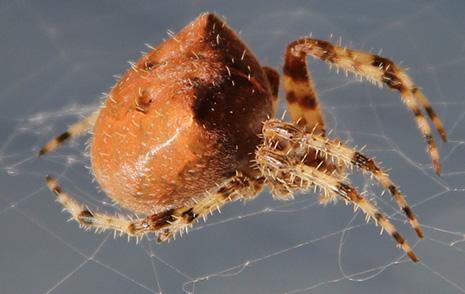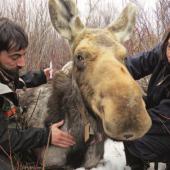My Cat-Faced Charlotte
Fall's eight-legged neighbors.
I wander out to my garage at odd hours to stare at her, fascinated and giddily horrified. She’s usually lurking near the center of an enormous web that covers the entire window: the biggest, fattest spider I’ve ever seen. Her grossly bulbous abdomen is about the size of a cocktail onion, and looks like a cross between a puffball mushroom and the carapace of a Dungeness crab, with two nippled points.
I first noticed her before her abdomen ballooned, just a very large, lanky spider in what looked like leopard tights, stretched out in a plank position on the web. The window she has commandeered is fly-spotted, filthy, and strewn with dead insects. Location, location, location.
Even though I was mortified by the window, I sent a picture of the swollen spider to Laurie Kerzicnik, an insect specialist at Montana State University. Apparently those nippled points looked like cat ears to whoever gave Araneus gemmoides its common name, “cat-faced spider.” A. gemmoides is one of 161 North American species in the family of orb-weaving spiders, Araneidae. Orb weavers won’t dash across your foot or wander into the house accidently because they’re clumsy crawlers, and don’t voluntarily leave their webs. Laurie sent me back a cheerful email, saying that people tend to notice cat-faced spiders in the fall when they start to get so big. “It is a beautiful, harmless spider,” she wrote. “I love to watch them on my porch when I have them. She will lay an egg sac before winter comes, and the egg sac will overwinter (she will die).”
My giant garage spider is my own Charlotte, in a messy spiral web that is the sum total of her universe for the rest of her life. It’s mid-October, so I imagine she will get to the egg-sac task soon, so she can deposit the hundreds of eggs growing inside that puffed up carapace. She has probably already done the reproductive deed, although it’s more protocol than deed. The much smaller male makes a little web to catch sperm he releases from his abdomen, which he then loads onto appendages called “pedipalps” that look like boxing gloves at the front of his head. Thus rigged, he searches for a female receptive enough to receive his sticky little mess. With a quick uppercut to her genital area it’s over. The female, who may or may not eat him after that, stores the sperm, which she uses to fertilize her eggs when she’s ready to build the egg sac. In the spring, the mob of newly hatched spiderlings gobble each other up in an arachnid Hunger Games. The survivors parachute away, carried on the breezes by gossamer wisps of silk.
In two weeks of obsessive watching, I can now predict where my cat-faced Charlotte will be in the web based on the time of day, although I’ve never seen her actually move. When the morning sun shines through the east-facing window, she hangs out in the shadows by a 16-penny nail pounded into the header. She’s anchored a sort of hammock to the nail, a denser area of web to rest in. She’s immense. She’s doomed. I love her.
As of this morning, there is still no egg sac. It will be a cold and quiet winter out there in the uninsulated garage, but I’ll resume watch in the spring. Maybe I’ll even catch the hatch. To protect the environment for the cat-faced future, I’m not going to wash the window. Coexistence is beautiful.













